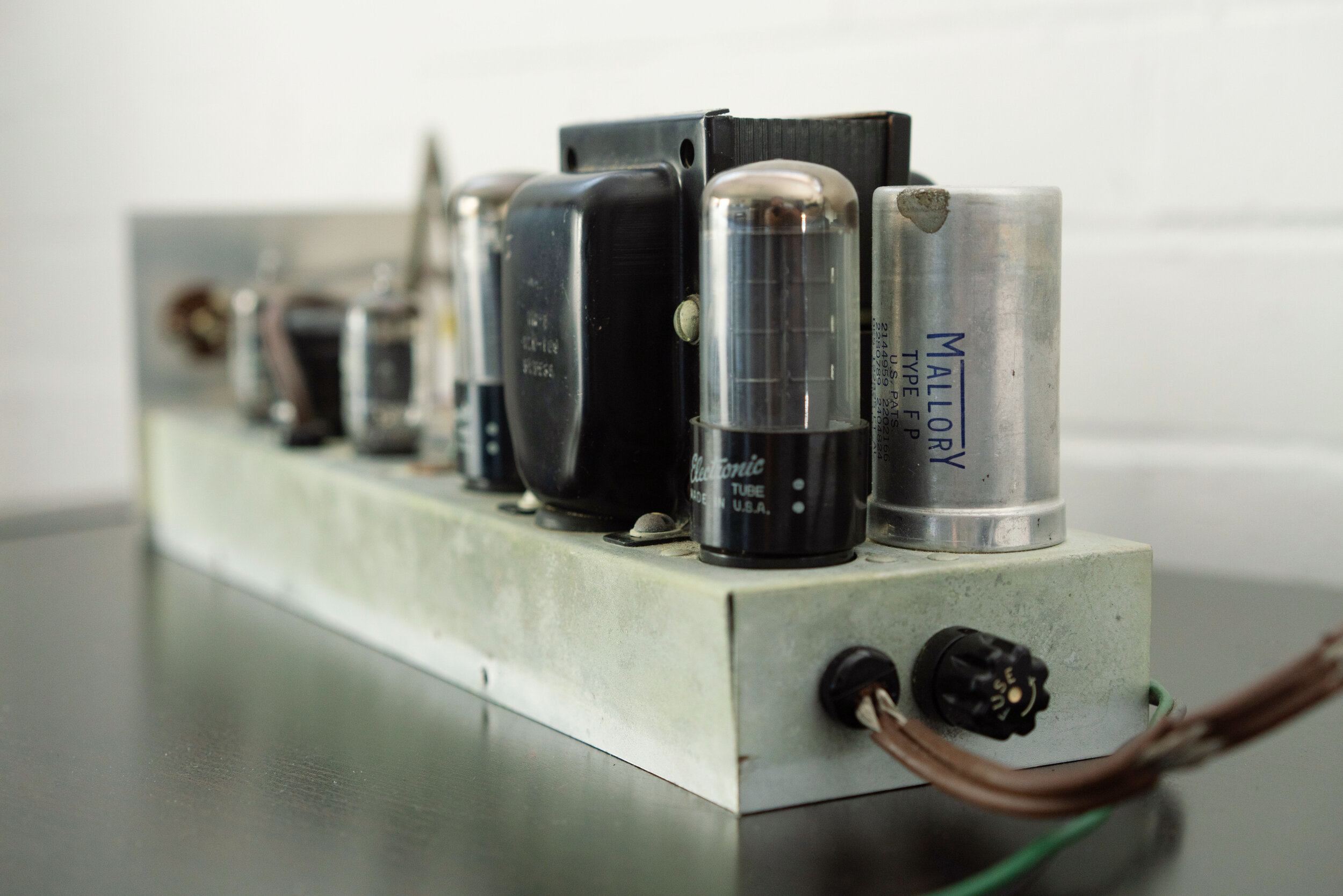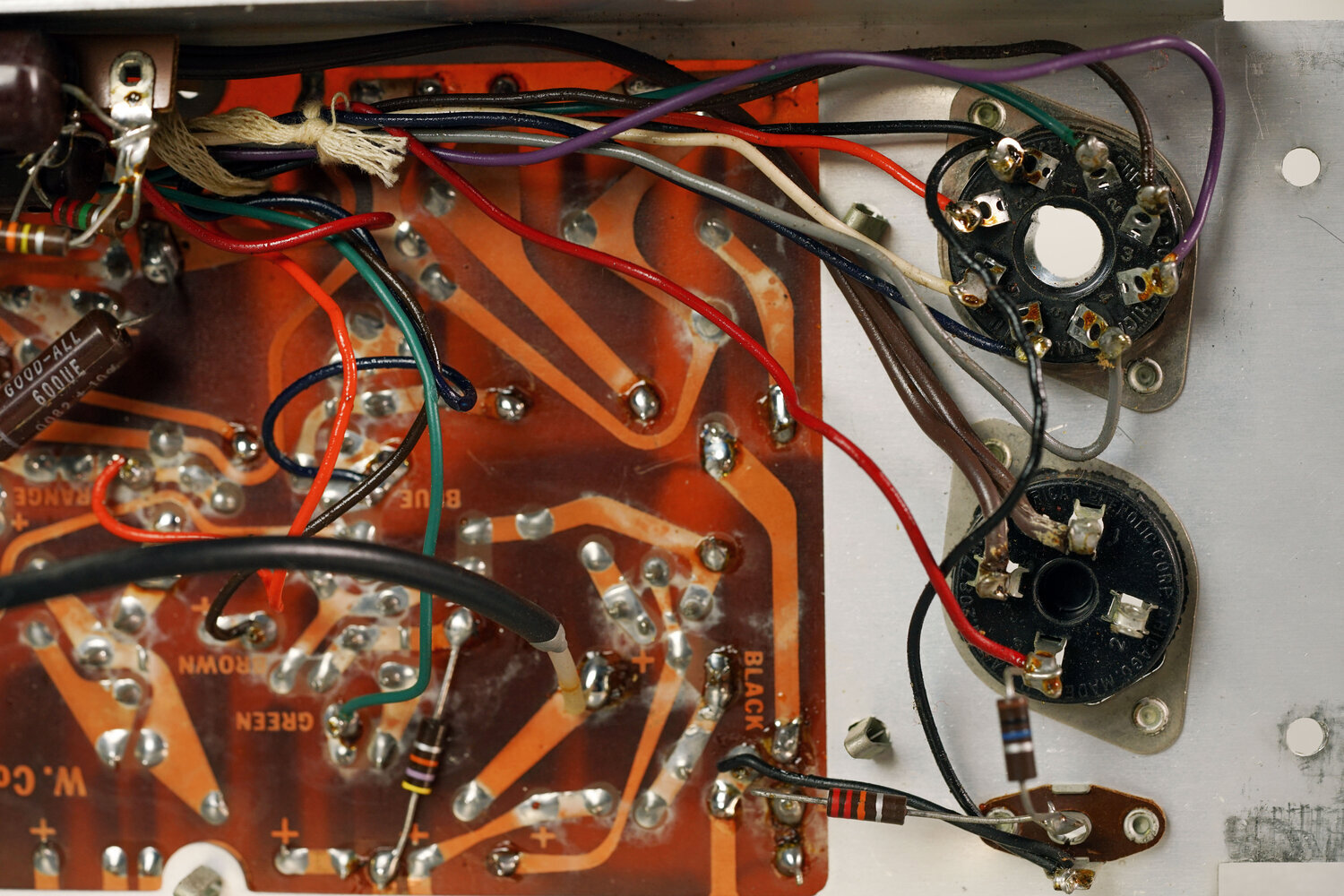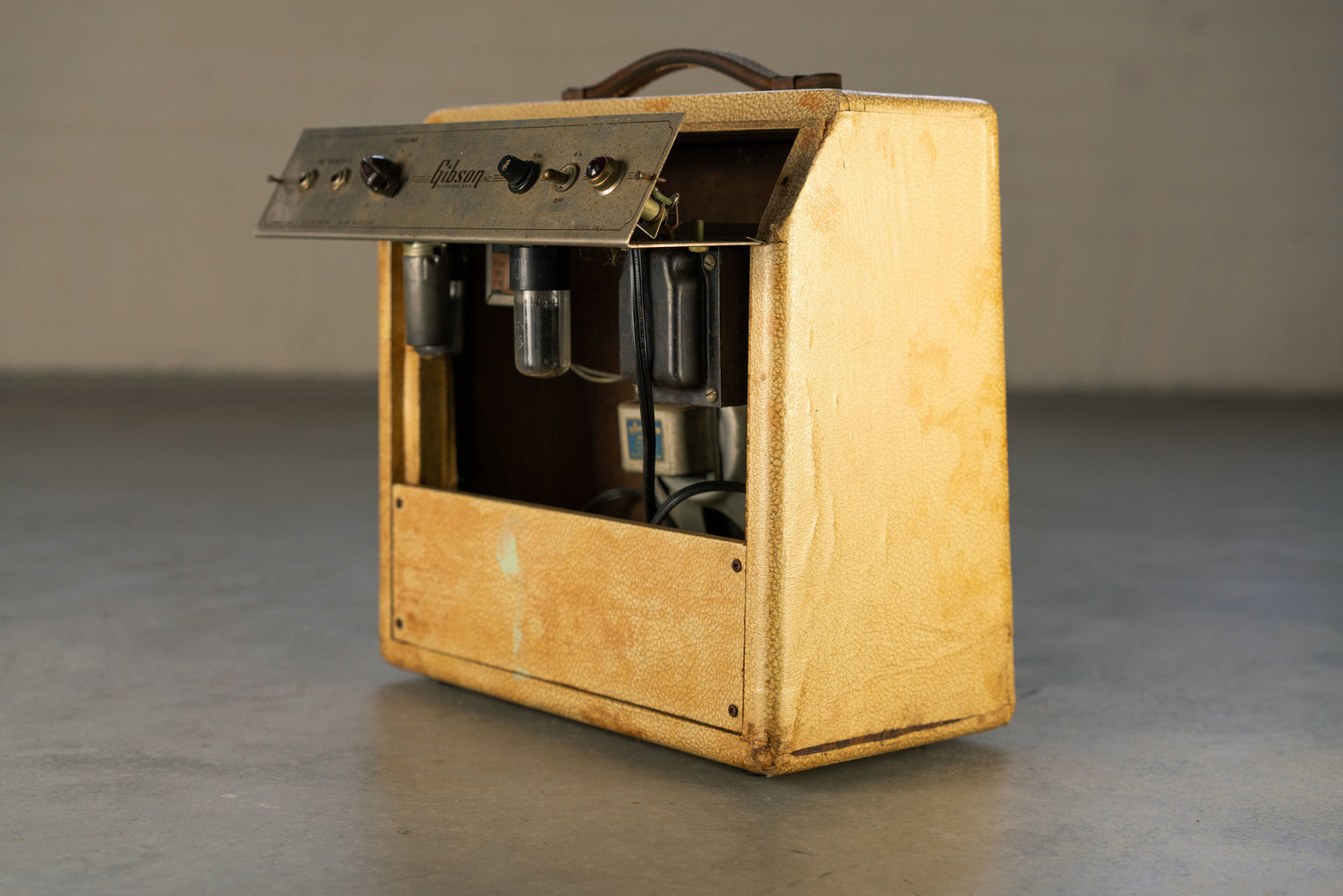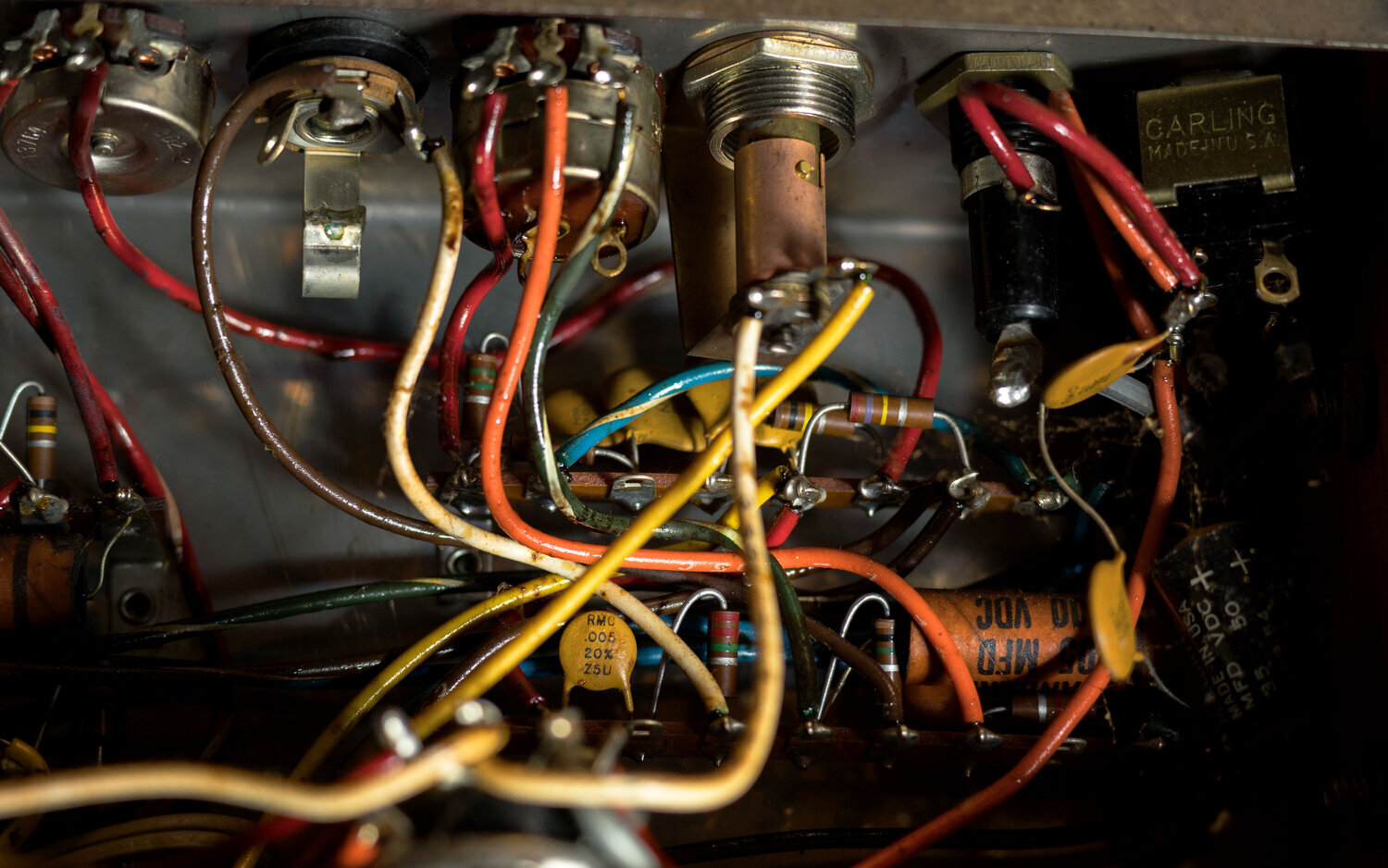Common Tube Amp Malfunctions: My amp doesn't turn on.
The pilot light on a Wurlitzer 200. It is mounted between the volume knob (which is also the on/off switch) and the vibrato knob.
The circuitry that turns the amp on and off is very simple: pretty much just some wiring that provides line voltage to the transformer. More commonly, this wiring is in great shape, voltage passes through it with no problem at all, the amp turns on, all the bad components inside receive all the power that the circuit can offer, and then the amp starts malfunctioning.
It’s important to distinguish between an amp that doesn’t turn on, and an amp that doesn’t make sound. Not turning on is likely a power supply issue, while not passing signal is a more general problem that could be located in the preamp, power amp, or speaker. If you hear anything out of your speaker, even just a quiet hum, your amp is officially on and you have a no-signal problem.
SAFETY NOTES
Audio amplifiers, and tube amplifiers in particular, contain high voltages. Do not attempt to repair an amplifier without following the appropriate safety protocols. This includes (but is not limited to) discharging the electrolytic capacitors if you are troubleshooting the circuit within the amp chassis. Note that electrolytic capacitors can pose a shock hazard even in the amp is turned off and unplugged.
Steps to diagnosing an amp that doesn’t turn on
Check for trivial problems.
Is the amp plugged in? Are the tubes present? Is the speaker connected? Is the wall outlet working correctly?
The wall outlet is an important one to check. A working wall outlet is a normal, everyday occurrence. Outlets provide us with electricity and we barely have to think twice about it, whereas its a miracle that the 40+ year old amplifier plugged into it still exists, let alone turns on. Basically, when the outlet fails, it is natural to scapegoat the gear instead. But double-checking the outlet isn’t wishful thinking: it’s covering your bases. It’s worth testing the amp in a different outlet before you start troubleshooting.
More on trivial problems here.
Is the pilot light on?
The classic indication of a broken amp is a dark pilot light. However, if your amp is truly in abysmal condition, it is possible that your pilot light is broken and you also have an independent no-signal problem deeper in the circuit. Not likely, but definitely possible. Keep that in mind.
In the Wurlitzer 120 service manual, Wurlitzer claims that the neon pilot light should last “indefinitely.” Although most 120 pilot lights are indeed still functional, nothing is indestructible.
If you are getting nothing from your pilot light, move on to the next section and check your fuse. However, if your pilot light is on, it means that you are successfully getting the appropriate voltage to your pilot light. So, at least part of your circuit (granted, a very small part) is working fine. But which part of the circuit? It depends on where the pilot light is located.
In a vintage amp, the pilot light is usually found in one of two places:
The primary side of the power transformer. Good news! You can safely deduce that your wall outlet is working. All wires leading up to your pilot light are probably in good shape too. The circuitry following your pilot light, however, is a question mark. In many vintage amplifiers, the pilot light even precedes the fuse. For that reason, you can’t make too many assumptions from a working pilot light, and you should still confirm that the fuse is intact.
In a tube amp, on the secondary 6.3v winding of the power transformer. This means that everything on the primary side is probably more or less working fine, because pilot-light-approved amounts of voltage are being passed to the heater secondary winding. Your question now: is the power transformer’s high-voltage secondary functional? (An easy test: are you getting the expected voltage from the high voltage secondary?) If not, your power transformer is malfunctioning and probably should be replaced. However, if your power transformer is working, your amp is officially on and you actually have a no-signal problem.
Occasionally, the pilot light will be located somewhere else in the circuit. For instance, in the Wurlitzer 120, the 120v pilot light is powered by the DC power supply which powers the tubes. If the pilot light in your Wurlitzer 120 is not working, you should confirm that the power supply is working correctly, and all DC voltages are as expected.
Enjoying this article? Subscribe to our newsletter for weekly repair tips & other vintage amplifier & electronic piano content!
Is the fuse present and intact?
All amps, with the exception of some cheap and unsafe vintage models, have a mains fuse. A fuse is a very thin piece of wire enclosed in glass. If the amp is working normally, the fuse completes the circuit like any other piece of wire. But if the circuit experiences an inrush of excessive current, the wire inside the fuse will burn up and the amp will power off, just as if you’ve hit the switch.
The fuse is usually mounted somewhere around the power cord, inside a fuse holder with a plastic cover. In some amplifiers, for instance the 200 and 200a, the fuse is hardwired into the amplifier and must be replaced by a tech. In the case of the Wurlitzer, you can still remove the lid and examine the fuse (although you must unplug the amp first and be sure to avoid touching any circuit components).
Never replace a fuse with one that has a larger current rating than the amplifier calls for.
If no fuse is present, the amp cannot physically turn on. Fuses are inexpensive and can be purchased at any hardware store, so replacing it is trivial. However, if the amp is new-to-you, an absent fuse is cause for suspicion. It’s completely possible that the fuse is missing because it blew the last time that the amp was powered on. However, the fuse might also be missing for some innocuous reason: for instance, because the previous owner removed it and placed it in a different amp.
If the fuse is present and blown, the amp can’t turn on because the circuit providing mains voltage is open. Simply replacing the fuse may or may not solve the problem. If the fuse blew due to a fault in the mains voltage, such as a brief power surge, replacing it is probably sufficient to make the amp work again (as long as the fault in the mains voltage has been resolved, of course). However, if you replace the fuse and the amp continues to blow, there is clearly an issue in the amp that must be resolved before the fuse is replaced again.
The fuse for the Wurlitzer 112, which is mounted very close to the power cord, power transformer, and rectifier tube. This fuse can only be accessed if the lid is off. However, most amplifier fuses are more accessible than this.
If the fuse is blown, the amp has experienced an excess of current. This excessive current can be inside the amplifier (i.e., a circuit fault) or outside the amp. For instance, there may have been a power surge, or a fault in the power cord or outlet causing a short. If you can solve the exterior problem (for instance, by replacing the power cord, using a new outlet, or unplugging other devices from the mains circuit), you can replace the fuse and — if it did its job and blew before the excess current damaged any other components — the amp should work as normal.
On the other hand, if the problem is in the amplifier, the fuse will continue to blow until the fault in the amp is addressed. Faults that blow fuses include a short in the transformer or tube, or a short in the AC or high-voltage wiring. In order to find the short, you must remove as many components as possible from the circuit to isolate the problem area. One way to do this is by plugging the amplifier into a lightbulb current limiter and removing all the tubes. If the bulb glows with no tubes installed, this indicates that there is a short in the circuit. If the bulb does not glow, replace the tubes one by one (safely, with the amplifier off). If the bulb glows after you replace a tube, the short is in that tube.
Note that operating the amplifier when it is shorted can be dangerous. Tests should only be conducted if you have the experience and the ability to do so safely. Otherwise, a tech should take over at this point.
If the fuse is present and does not appear to be blown, you can use a multimeter to confirm that the fuse is still good. A good fuse will have continuity across the terminals. It can be hard to visually see the break in the fuse, so test it with a multimeter anytime you aren’t sure.
Next steps if the fuse is not blown and the amp does not turn on
If the fuse is intact but the amp still doesn’t turn on, it is very likely that some part of the circuit is open or disconnected. If the amp has no signs of life whatsoever, the problem is probably very early in the power supply, or in the power transformer primary. Interruptions in the wiring here are more likely to create a bottleneck that prevents the rest of the circuit from receiving adequate voltage. On the secondary side of the power transformer (i.e., the side with the audio circuit), voltage branches off into different directions, powering parts of the circuit that will probably, at minimum, allow you to hear some sort of white noise or hum from the speaker, even if the audio signal is cut off.
Interlude
What is the difference between a transformer’s primary and secondary windings?
A transformer is composed of long coils of metal wire wound around an iron core. Each coil is called a winding. A voltage applied to one winding will induce a voltage in the opposite winding — not because the windings are connected (in fact, they are not) but because the design of the transformer creates a magnetic field that induces a voltage via something called mutual induction. When talking about transformers, it is important to distinguish between which side receives the input voltage (the primary) and which side outputs the induced voltage (the secondary).
The winding that is connected to the input voltage is called the primary winding, while the opposite winding (which receives the indirect, induced voltage) is the secondary winding. In an amplifier, the power transformer primary winding is the side that is connected to the power plug and the wall outlet. The secondary is connected to the rectifier.
Compare to the amplifier’s output transformer. Here, the side connected to the power tubes is the primary, because that’s where the signal comes from. The side connected to the speaker is the output, and therefore the secondary.
For this reason, pay close attention to the AC connections on the primary side of the transformer. This includes the power receptacle, fuse holder, switch, pilot light, and transformer wires. A frayed wire or broken solder joint may be interrupting the voltage. Or, some part of the circuit may be unintentionally grounded.
With the amplifier unplugged, use the continuity feature on a multimeter to ensure that all wires, including the power cord, have appropriate continuity. Ensure that the switch has continuity when it is in “on” position (again, do this when the amp is unplugged). Ensure that the wires leading to the rectifier are in good shape and solidly connected. Find the power transformer center tap and confirm that it is appropriately grounded. Some amplifiers have additional fuses near the rectifier or power transformer secondary: are they blown? Note that you must discharge the filter capacitors before replacing secondary fuses, making continuity tests or otherwise working inside the amplifier (even if it is turned off and unplugged).
If all wiring checks out, the power transformer should be examined for open windings. Is it providing the expected voltage to the rectifier? These tests are more advanced, since they may involve taking voltages while the amp is running or disconnecting components for more accurate readings. If you are a beginner, you may want to hand the amp to a tech at this point. Contact us for details about our mail-in amplifier service.
If the amplifier uses tubes, check for tube glow. This indicates that the power transformer’s heater windings are likely functional. Depending on the particulars of the tube, heater glow may be obvious, or somewhat faint. In some amplifiers, the rectifier tube is on a separate winding. Heater glow tends to imply that connections on the transformer primary are working at least sufficiently to energize the heater winding. So, if the amp appears dead but has heater glow, focus on the high-voltage secondary and the rectifier circuit.
Further Reading
Browse all of our articles on restoring vintage gear. Or, click on an image below.







